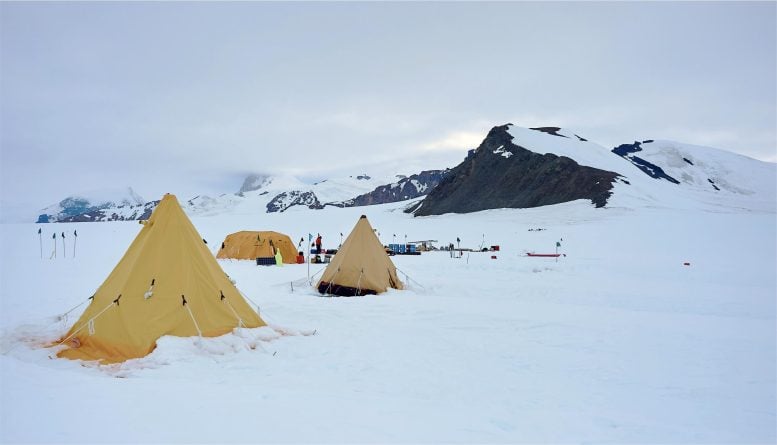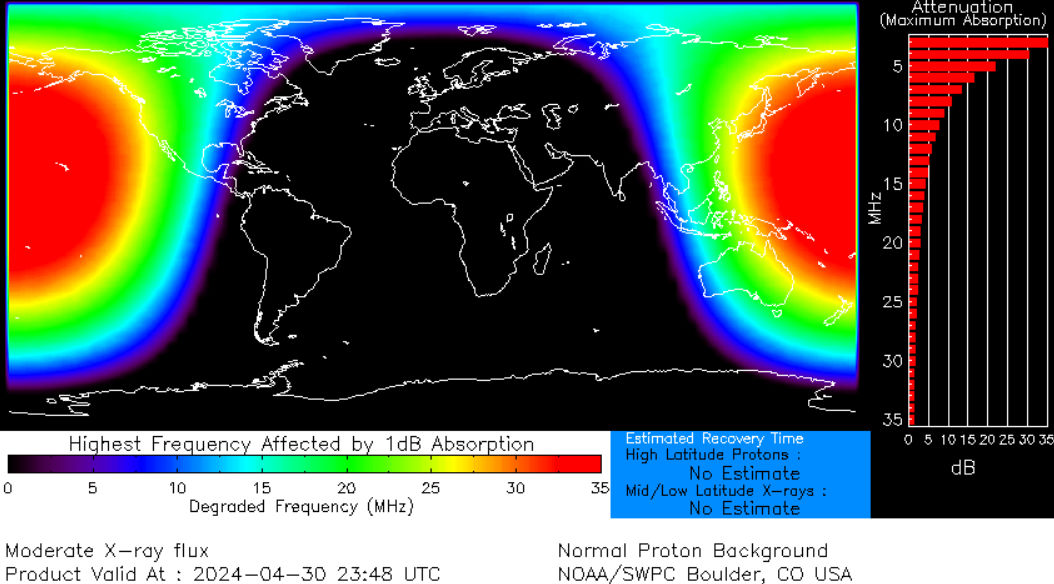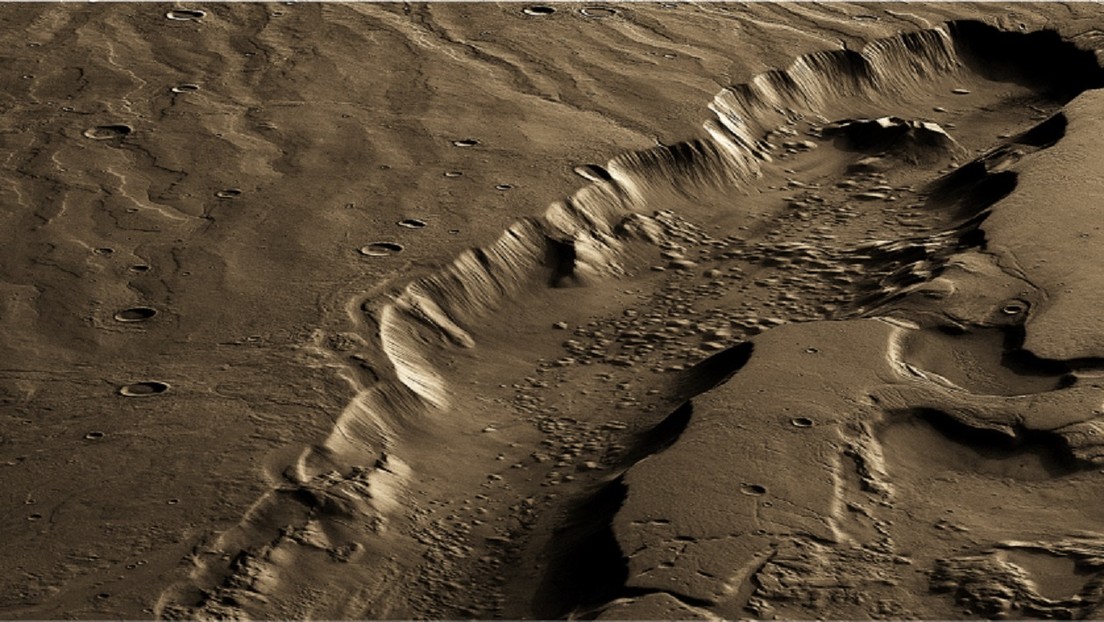Horoscopo
Las rocas debajo de la capa de hielo de la Antártida revelan un pasado sorprendente

El campamento de campo en el glaciar Thwaites donde se basó el equipo para la perforación. Crédito: Greg Balco (Centro de Geocronología de Berkeley)
Investigadores internacionales[{» attribute=»»>Thwaites Glacier Collaboration found that the West Antarctic Ice Sheet had been thinner in the past and had regrown, suggesting that glacial retreat could be reversed. The study used rock samples to show that ice near Thwaites Glacier was at least 35 meters thinner in the last 5000 years and took a minimum of 3000 years to reach its current size. However, this recovery timeframe poses concerns given the expected impact of sea level rise due to imminent climate change.
The West Antarctic Ice Sheet is shrinking, with many glaciers across the region retreating and melting at an alarming rate. However, this was not always the case according to new research published last month in The Cryosphere. A team of scientists from the International Thwaites Glacier Collaboration (ITGC), including two researchers from the British Antarctic Survey (BAS), discovered that the ice sheet near Thwaites Glacier was thinner in the last few thousand years than it is today. This unexpected find shows that glaciers in the region were able to regrow following earlier shrinkage.
Sea level rise is already putting millions of people in low-lying coastal communities around the world at risk from flooding. The contribution from melting Antarctic ice is currently the greatest source of uncertainty in predictions of how much and how quickly the sea level will rise in the coming decades and centuries. Together with its immediate neighbor, Thwaites Glacier currently dominates the Antarctic contribution to sea level rise. To understand how this important glacier will respond to the climate changes expected in the coming century, scientists need to know how it behaves under a wide range of climatic conditions and over long timescales. Since satellite observations only go back a few decades in time, we need to look at the geological record to find this information.

The rock cores were taken back to the lab from Thwaites for analysis. Credit: Keir Nichols (Imperial College London)
Jonathan Adams, co-author and PhD student at BAS, says:
“By studying the history of glaciers like Thwaites, we can gain valuable insight into how the Antarctic Ice Sheet may evolve in future. Records of ice sheet change from rocks that are presently exposed above the ice sheet surface end around 5000 years ago, so to find out what happened since then, we need to study rock presently buried beneath the ice sheet.”
Using drills specially designed to cut through both ice and the underlying rock, the team recovered rock samples from deep beneath the ice sheet next to Thwaites Glacier. They then measured, in those rock samples, specific atoms that are made when rocks are exposed at the surface of the Earth to radiation coming from outer space. If ice covers those rocks, these particular atoms are no longer made. Their presence can therefore reveal periods in the past when the ice sheet was smaller than the present.
Keir Nichols, a glacial geologist from Imperial College London and a lead author of the study, says:
“This was a huge team effort: several of us spent weeks away from home doing fieldwork in an extremely remote part of Antarctica, whilst others endured literally thousands of hours in the lab analyzing the rocks we collected. The atoms we measured exist only in tiny amounts in these rocks, so we were pushing right to the limit of what is currently possible and there was no guarantee it would work. We are excited that this is the first study to reveal the recent history of an ice sheet using bedrock collected from directly beneath it.”
The team discovered that the rocks they collected were not always covered by ice. Their measurements showed that, during the past 5000 years, ice near Thwaites Glacier was at least 35 meters thinner than it is now. Furthermore, their models demonstrated that its growth since then – making the ice sheet the size it is today – took at least 3000 years.
This discovery reveals that ice sheet retreat in the Thwaites Glacier region can be reversed. The challenge for scientists now is to understand the conditions required to make that possible.
Joanne Johnson, a geologist at BAS and co-author of the study, says:
“On the face of it, these results seem like good news – Thwaites Glacier was able to regrow from a smaller configuration in the geologically-recent past. However, our study shows that this recovery took more than 3000 years, in a climate that was likely not as warm as what we expect for the coming centuries. If we want to avoid the impacts of sea level rise on our world that will result from continued retreat of the West Antarctic Ice Sheet, that timescale is far longer than we can afford to wait.”
Reference: “Reversible ice sheet thinning in the Amundsen Sea Embayment during the Late Holocene” by Greg Balco, Nathan Brown, Keir Nichols, Ryan A. Venturelli, Jonathan Adams, Scott Braddock, Seth Campbell, Brent Goehring, Joanne S. Johnson, Dylan H. Rood, Klaus Wilcken, Brenda Hall and John Woodward, 28 April 2023, The Cryosphere.
DOI: 10.5194/tc-17-1787-2023

Experiencia en periódicos nacionales y periódicos medianos, prensa local, periódicos estudiantiles, revistas especializadas, sitios web y blogs.
Horoscopo
Comparación de la tripulación comercial Boeing Starliner y SpaceX Dragon de la NASA

Uno de ellos ya ha transportado a ocho tripulaciones de la NASA y tres tripulaciones privadas a la Estación Espacial Internacional. El otro realizará su primer vuelo con tripulación la próxima semana.
Ambos pueden transportar hasta siete astronautas o una combinación de tripulación y carga. Ambos fueron diseñados para ser lanzados sobre cohetes y perseguir a la Estación Espacial Internacional, viajando a 17.500 mph (200-250 millas) sobre la Tierra, orbitando nuestro planeta cada 90 minutos. Chocamos contra el océano. Las otras “tierras blandas” del desierto.
El objetivo de ambas naves espaciales era encontrar una manera de proporcionar transporte a la ISS para los astronautas de la NASA, ahora que el transbordador espacial de vuelos largos había sido retirado. Ambos fueron seleccionados para recibir financiación pública en 2014 en virtud del contrato de tripulación comercial de la NASA.
Mientras Boeing se prepara para lanzar su cápsula Starliner en su primera misión tripulada a las 10:34 p.m. del 6 de mayo desde el Complejo de Lanzamiento 41 en la Estación Espacial de Cabo Cañaveral, esto es lo que necesita saber sobre Starliner y cómo se compara con SpaceX Dragon.
Boeing Starliner transportará astronautas de la NASA
Boeing lo llama el Transporte espacial de tripulación (CST) -100 Starliner, o simplemente “Starliner”. Su lanzamiento, cuyo lanzamiento está previsto para no antes del 6 de mayo, hará historia como la primera nave espacial en transportar humanos desde el Complejo de Lanzamiento Espacial 41. La plataforma ha sido el sitio de lanzamiento de misiones históricas que comenzaron con los cohetes Titán en 1965 e incluyeron el espacio profundo New Horizons. sonda, la nave espacial Voyager e incluso el rover Curiosity Mars.
Qué se lanza Dónde:Años después del retiro del transbordador espacial, Florida continúa con casi 70 lanzamientos al año
Recientemente se agregó al sitio un brazo de acceso para la tripulación en preparación para la prueba de vuelo con tripulación del Starliner, que se lanzará utilizando un cohete Atlas V ULA (una asociación entre Boeing y Lockheed Martin). El cohete Atlas V se lanza desde este lugar desde 2002, pero esta será la primera vez que llevará astronautas al espacio.
No te pierdas el próximo lanzamiento en Florida:¿Hay lanzamiento hoy? Próximo calendario de lanzamiento de cohetes para SpaceX, ULA y NASA en Florida
Boeing Starliner nombrado Calipso para esta misión
Como parte del Programa de tripulación comercial de la NASA, Boeing pretende que su Starliner transporte regularmente a astronautas de la NASA tras el éxito de esta próxima prueba de vuelo con tripulación. Una vez certificado por la NASA, Starliner se unirá al Dragon de SpaceX, que lleva tripulaciones de la NASA desde 2020. Boeing afirma actualmente que la NASA ha comprado seis misiones tripuladas adicionales más allá de esta próxima prueba de vuelo.
Según Boeing, una cápsula tripulada Starliner puede volar hasta 10 veces, con una vida útil de seis meses entre misiones.
La cápsula que voló el lunes recibió el nombre Calipso por la astronauta Sunita «Suni» Williams. En un guiño a su amor por el océano y la exploración, Williams dijo en 2019 que llamó a la cápsula Calipso después del barco Jacques Cousteau, quien fue un explorador oceánico a mediados del siglo XX. Este barco era conocido por su cámara de observación submarina y su equipo compuesto por un helicóptero y sumergibles, que ayudaban en las expediciones científicas. El comandante de la misión Butch Wilmore volará con Williams.
Boeing Starliner
apellido: Transporte espacial de tripulación (CST) -100 Starliner
Altura: 16,5 pies (cápsula + módulo de servicio)
Diámetro: 15 pies
Tamaño de la tripulación: Cuatro (puede transportar hasta siete)
Cohete: Lanzamiento en ULA Atlas V
Rampa de lanzamiento: Complejo de lanzamiento espacial 41
Reutilizabilidad de cohetes: vuelo único (ULA prueba la reutilización con Vulcan)
Destino: Órbita terrestre e ISS
Aterrizaje: Aterrizando en tierra bajo tres paracaídas y bolsas de aire en el suroeste de Estados Unidos.
Adjudicación del contrato de la NASA (2014): 4.800 millones de dólares
Boeing Starliner, primer atraque sin tripulación
El Starliner de Boeing se acopló con éxito a la Estación Espacial Internacional el 20 de mayo de 2022.
Dragón espacial X

apellido: Cápsula de la tripulación del dragón
Altura: 16 pies
Diámetro: 13 pies
Tamaño de la tripulación: Cuatro (puede transportar hasta siete)
Cohete: Lanzamientos en SpaceX Falcon 9
Rampa de lanzamiento: KSC 39A y Complejo de Lanzamiento Espacial 40.
Reutilizabilidad de cohetes: vuelos múltiples (Falcon 9 aterriza y vuela nuevamente)
Destino: Órbita terrestre e ISS
Aterrizaje: Se estrella en el océano bajo cuatro caídas principales después de usar dos paracaídas estabilizadores
Adjudicación del contrato de la NASA (2014): 3.100 millones de dólares
SpaceX Dragon, primer acoplamiento no tripulado
El SpaceX Dragon se acopló por primera vez a la Estación Espacial Internacional el 25 de mayo de 2012.
Brooke Edwards es reportera espacial de Florida Today. Contáctela en [email protected] o en X: @brookeofstars.

Experiencia en periódicos nacionales y periódicos medianos, prensa local, periódicos estudiantiles, revistas especializadas, sitios web y blogs.
Horoscopo
Los astronautas despegarán desde Cabo Cañaveral en su primer vuelo espacial tripulado en casi 56 años.

TAMPA, Fla. (WFLA) – Por primera vez en más de medio siglo, los astronautas despegarán de la estación espacial en Cabo Cañaveral, Florida, la próxima semana.
Si todo va según lo planeado, la nave espacial Boeing Starliner en un cohete Atlas V se lanzará desde Cabo Cañaveral, lo que será la primera vez que humanos despeguen desde la estación espacial en casi 56 años.
La última vez que se lanzó un ser humano al espacio desde Ciudad del Cabo fue a bordo del Apolo 7 en 1968.
Los dos astronautas de la NASA asignados al primer vuelo espacial tripulado de Boeing, Butch Wilmore y Suni Williams, llegaron a su sitio de lanzamiento la semana pasada, poco más de una semana antes de su despegue programado para el 6 de mayo.
Wilmore y Williams volaron desde Houston al Centro Espacial Kennedy el 25 de abril y servirán como pilotos de pruebas para la cápsula Starliner de Boeing, que hace su debut con tripulación después de años de retrasos.
El Starliner, que despegará el viernes sobre un cohete Atlas, volará a la Estación Espacial Internacional para un crucero de prueba de una semana. Boeing está tratando de alcanzar a SpaceX, que lanza astronautas para la NASA desde 2020.
En los dos vuelos de prueba anteriores del Starliner de Boeing no había nadie a bordo. El primero, en 2019, no he aprobado a la estación espacial debido a problemas de software y otros. boeing repetí la demostración en 2022. Más recientemente, la cápsula era presa por problemas con los paracaídas y cinta inflamable que hubo que retirar.
Wilmore enfatizó que se trataba de un vuelo de prueba destinado a descubrir todo lo que estaba mal.
“¿Esperamos que esto salga perfecto? Este es el primer vuelo humano de la nave espacial”, dijo a los periodistas. «Estoy seguro de que descubriremos cosas». Por eso hacemos esto.
La NASA contrató a SpaceX y Boeing hace una década, pagándoles miles de millones de dólares para transportar astronautas hacia y desde la estación espacial. La agencia espacial todavía quiere tener dos cápsulas para sus astronautas, incluso si la estación espacial cerrará en 2030.
«Es de vital importancia», señaló Wilmore.
Wilmore y Williams serán los primeros astronautas en viajar en un cohete Atlas desde el Proyecto Mercurio de la NASA a principios de los años 1960.
La Prensa Asociada contribuyó a este informe.

Experiencia en periódicos nacionales y periódicos medianos, prensa local, periódicos estudiantiles, revistas especializadas, sitios web y blogs.
Horoscopo
El sol arde cerca de una erupción solar de Clase X: la llamarada M9,5 provoca cortes de radio en todo el Pacífico (vídeo)

Anoche (30 de abril), el sol desató una llamarada solar extremadamente poderosa, provocando cortes de radio generalizados en toda la región del Pacífico. La erupción alcanzó su punto máximo a las 19:46 EDT (23:46 GMT) y terminó poco después a las 19:58 EDT (23:58 GMT).
Erupciones solares son erupciones de el solque emiten intensas ráfagas de radiación electromagnética. Se crean cuando la energía magnética se acumula en la atmósfera solar y se libera. Las erupciones solares se clasifican por tamaño en grupos de letras, siendo la clase X la más potente. Luego están las bengalas de Clase M que son 10 veces más débiles que las bengalas de Clase X, seguidas por las bengalas de Clase C que son 10 veces más débiles que las bengalas de Clase M, las bengalas de Clase B son 10 veces más débiles que las bengalas de Clase C y finalmente, las bengalas de Clase A que son 10 veces más débiles que las bengalas de Clase B y tienen sin consecuencias notables en la Tierra.
Dentro de cada clase, los números del 1 al 10 (y más allá para las bengalas de Clase X) describen la fuerza relativa de una bengala. La reciente erupción del 30 de abril alcanzó M9,53, según Spaceweatherlive.commedido por el satélite GOES-16 de la NASA, colocándolo solo una fracción por debajo de una erupción solar de clase X.
Relacionado: Mire 4 llamaradas solares surgen del Sol casi al mismo tiempo en un evento extremadamente raro (video)
Los apagones de radio de onda corta como el que se observa en el Pacífico son comunes poco después de poderosas erupciones solares debido al fuerte pulso de rayos X y la radiación ultravioleta extrema emitida durante el evento. La radiación se propaga hacia Tierra En velocidad de la luz e ioniza la parte superior de la atmósfera terrestre cuando nos alcance.
Esta ionización crea un entorno de mayor densidad por el que las señales de radio de onda corta de alta frecuencia deben intentar atravesar para permitir la comunicación a largas distancias. Ondas de radio que interactúan con electrones Las capas ionizadas pierden energía debido a colisiones más frecuentes, lo que puede provocar la degradación o la absorción completa de las señales de radio, según la Administración Nacional Oceánica y Atmosférica (NOAA). Centro de predicción del clima espacial.
La radiación de la erupción solar del 30 de abril afectó a los residentes de la parte soleada de la Tierra hasta el momento de la erupción, las regiones del Pacífico. «Los marineros y los radioaficionados pueden haber notado una pérdida de señal por debajo de 20 MHz durante hasta 30 minutos después del pico de la erupción». según Spaceweather.com.
La actividad solar se acelera a medida que nos acercamos al máximo solar, el pico de actividad solar durante aproximadamente 11 años de existencia del sol. ciclo solarindicado por la frecuencia de manchas solares.
A pesar del gran número de manchas solares actualmente visibles en la superficie del Sol, nuestra estrella ha permanecido relativamente tranquila en las últimas semanas. Pero ya no.
La llamarada solar casi de Clase X estalló en la región de manchas solares AR3654, la llamarada más poderosa jamás producida en esta región.
«Siempre es emocionante cuando una región de manchas solares alcanza su potencial. AR3654 acaba de lograrlo». El científico solar Alex Young publicó en X.
😱 Actualización 30 de abril de 2024: ¡Casi X llamarada! 👏💥🤩 Siempre es emocionante cuando una región de manchas solares está a la altura de su potencial. AR3654 acaba de hacerlo. A las 23:23 UTC del 30 de abril, la región desató una llamarada que casi alcanza a X con una M9.5. 🧐MÁS en EarthSky: https://t.co/xD29wLfm4e pic.twitter.com/efGC1G2Rn81 de mayo de 2024
«¡A pesar de una gran cantidad de manchas solares en las últimas dos semanas, la #SolarFlare de Clase X cercana a esta noche es la primera llamarada de tamaño decente en mucho tiempo! ¿Cuándo y dónde tendrá lugar la próxima Clase?» El astrofísico solar Ryan French publicó en X.
A pesar del alto número de manchas solares en las últimas semanas, ¡la #SolarFlare de clase X de esta noche es la primera llamarada de tamaño decente en mucho tiempo! ¿Cuándo y dónde se llevará a cabo el próximo evento de Clase X? #clima espacial pic.twitter.com/Thbrjy2XMy1 de mayo de 2024
Los científicos solares monitorean de cerca el sol a medida que se acerca al máximo solar, porque la actividad solar puede afectar nuestras vidas en la Tierra.
Las poderosas llamaradas pueden afectar significativamente a las naves espaciales, satélites y tecnologías terrestres, se mueven a la velocidad de la luz y no dan mucho aviso antes de atacar. Es por eso que muchas organizaciones, incluidas la NASA, la NOAA y la Agencia Meteorológica de la Fuerza Aérea de EE. UU. (AFWA), monitorean de cerca el sol. Estas organizaciones pueden enviar advertencias a los sectores de tecnología e infraestructura vulnerables a las erupciones solares para que se puedan tomar las precauciones adecuadas en caso de condiciones climáticas espaciales potencialmente peligrosas.
«No podemos ignorar clima espacialpero podemos tomar las medidas adecuadas para protegernos”, La NASA dice.
Pero no hay necesidad de preocuparse; las llamadas «llamaradas asesinas» no existen, y si bien las erupciones solares tienen el potencial de perturbar significativamente el mundo tecnológico, no contienen suficiente energía para causar daños duraderos a la Tierra misma.
«Incluso en el peor de los casos, las erupciones solares no son físicamente capaces de destruir la Tierra», afirma la NASA.

Experiencia en periódicos nacionales y periódicos medianos, prensa local, periódicos estudiantiles, revistas especializadas, sitios web y blogs.
-
Horoscopo3 años ago
Horóscopo: ¿qué dice tu ascendente para hoy y el fin de semana del 27 de noviembre?
-
Entretenimiento2 años ago
¿Britney Spears y Sam Asghari están casados? Planes después de la conservación
-
Ciencia y tecnología3 años ago
Localizan la región de Marte más apropiada para la existencia de vida.
-
Negocios3 años ago
Reguladores federales investigan bolsas de aire en vehículos 30M
-
Deportes5 meses ago
Vista previa: Perú vs Brasil – predicciones, noticias del equipo, alineaciones
-
Horoscopo3 años ago
Paseo espacial estadounidense fuera de la Estación Espacial Internacional pospuesto debido a un problema médico con el astronauta
-
Entretenimiento3 años ago
Eva Longoria, Shonda Rhimes y Jurnee Smollett abandonan la junta de Time’s Up: «Listos para un nuevo liderazgo»
-
Deportes4 meses ago
Kyogo Furuhashi anota y Japón venció a El Salvador 6-0 en un amistoso | Noticias de futbol











